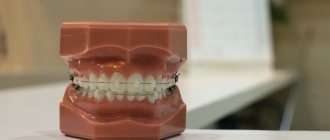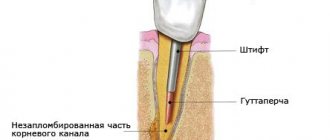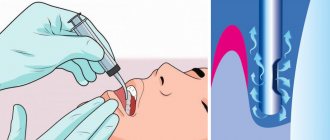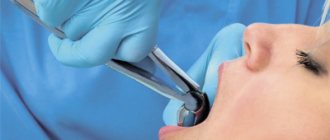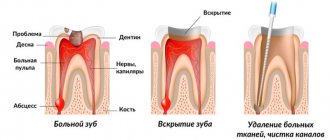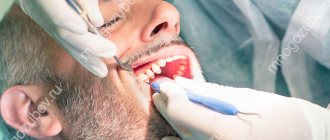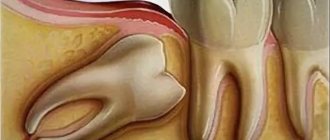From this article you will learn:
- Tooth pulled out, gums hurt: what to do.
- why gums hurt after tooth extraction: reasons,
- How many days should the pain last?
The article was written by a dental surgeon with more than 19 years of experience.
Many patients complain that their gums hurt in the first days after tooth extraction. Pain is the body's normal response to injury, and therefore mild pain that does not last long is normal. However, pain occurs not only as a consequence of injury to the bone and gums, but also because inflammation of the gums could develop after tooth extraction.
According to statistics, inflammation and improper healing of the socket after tooth extraction occurs in 3-5% of cases (but this applies to teeth of any location except wisdom teeth). But the removal of the eighth teeth leads to the development of complications in approximately 25-30% of cases. This article will help you understand the cause of the pain, whether your tooth socket is healing properly, and what to do if it becomes inflamed.
Type of gums after tooth extraction (normal) –
Please note that normally, the socket of each extracted tooth should be completely covered with a blood clot. The surface of the clot should first be an intense burgundy color, gradually becoming yellowish-whitish. What the sockets should look like at different times after extraction - see the article: → “Healing the sockets of extracted teeth: photo”
Why does a pulled out tooth hurt?
The presence of pain after tooth extraction is due to the fact that during such a procedure soft tissues, blood vessels and nerves are damaged.
Typically, the first pain symptoms appear 3-4 hours after surgery. This is due to the fact that this is when the anesthesia stops working. Also, during removal, the bone tissue of the jaw socket may be damaged. In this case, the pain during the healing period is more intense and prolonged. However, if the removal was carried out correctly, it will soon pass.
How long does it hurt?
In most cases, pain during removal worsens on the second day. On the third day they begin to decrease. By the fourth or fifth day, there is practically no pain. If by this period the pain after tooth extraction does not subside, the patient should consult a doctor, as this may indicate the emergence of complications.
However, it is important to remember that complete healing of the hole occurs only in the second or third week after the procedure. Until this time, the gums and bone tissue are vulnerable, so if they are irritated, pain may also occur. To prevent this from happening, you should follow your doctor's recommendations.
Headache
The recovery period after tooth extraction may be accompanied by headaches of varying intensity. They are associated with damage to the nerve fibers that go to the brain. Such symptoms should not frighten the patient, since as the wound heals, they will also pass.
Another cause of headaches during this period may be hypertension. The patient must notify the attending physician about the presence of such an illness. In this case, the surgeon will be able to select appropriate medications that will reduce pain.
Ear pain
For the same reasons, a patient may experience unpleasant or even painful sensations in the ear after tooth extraction. Most often they have a shooting character. This symptom is also normal and goes away in the coming days after the intervention.
Ear pain may worsen if, after the procedure, the patient does not properly care for the oral cavity and tries to chew solid food.
Pain in the gums
Pain in the gum is associated with its direct damage. In this case, not only the soft tissue suffers, but also the nerves, which are also located in the gums. Depending on the degree of damage, pain can last for different times and occur with greater or less intensity.
Increased pain in the gum may indicate the presence of fragments in its tissues, as well as the occurrence of one or another complication. If such symptoms occur, you should immediately consult a specialist.
How long does a tooth hurt after extraction is normal?
Ripping out permanent units is a full-fledged operation. During it, the integrity of soft tissues and mucous membranes is damaged. If the regeneration process proceeds well, then after 1-2 days the patient feels great. The maximum period during which the removal area can hurt is three days.
If after its expiration the symptom does not go away, but on the contrary, becomes brighter and stronger, you should immediately visit the dental clinic. Delay is dangerous, as complications may develop.
Will the site of the extracted tooth stop hurting on the second day?
Patients often believe that the pain at the site of pulled out teeth should go away after sleeping on the second day, and they get scared when it becomes even stronger. This situation is normal, since after a certain time the damaged gum tissue begins to swell, thereby pinching the nerves. All this leads to pain becoming more intense.
You need to be prepared for this. Today there are a large number of analgesics and other medications that can reduce inflammation and eliminate pain syndromes.
What determines the severity of pain in the absence of pathology?
Patients often complain that they have had a tooth removed and their gums hurt. The more complex the tooth extraction operation performed by the doctor, the greater the trauma caused to the bone and soft tissues, which means the stronger the pain.
Difficult tooth extraction may be required in cases where:
- when you try to remove a tooth, it crumbles into pieces;
- when it has crooked roots;
- when the tooth has rotted down to the gum and is difficult to grab to pull it out.
In all situations where access to dental tissue is difficult, an operation is performed that is highly traumatic. In these cases, in order to free the tooth from the gum and bone tissue, the doctor has to cut the gum, separate it from the bone, saw the tooth piece by piece, and then remove it.
That is why difficult tooth extraction and severe pain after it are a natural syndrome. Therefore, the patient should be prepared for the possibility of discomfort if a tooth is removed. Teeth pain is a normal physiological process. The place where the operation was performed will be of concern. The cheek on the extraction side may also hurt (due to swelling of the soft tissues), and reflected pain may even be in neighboring teeth.
The site of tooth extraction hurts after a week, what should I do?
The holes in which the extracted teeth were located are usually completely healed by the end of the first week. Final healing still needs to wait, but the pain should have passed during this period. If, after a week, the area continues to hurt after tooth extraction or any other symptoms appear, such as bleeding, the patient urgently needs to see a doctor.
Under no circumstances should you try to relieve pain on your own. If it continues to bother the patient, this may indicate the development of inflammation or an abscess process in the gum. If they are not eliminated in time, the consequences can be very serious.
If a tooth in which the nerve has been removed hurts
Many people believe that if the nerve is removed during treatment, the tooth will never bother you again, because there is nothing to hurt anymore. However, as soon as a person gets into a stressful situation or gets cold, the tooth without a nerve begins to ache and shoot. In this case, people have to contact the dentist again with the complaint that the nerve was removed and the tooth hurts. It must be said that for doctors such statements do not seem surprising at all, because teeth without nerves hurt people very often. And doctors’ recommendations in such situations are almost formulaic: it is necessary to re-drill and then treat the canals of the tooth.
Stages of socket healing
The holes in the place of pulled out teeth heal in several stages. The first one lasts about a week. At this time, the wound heals, its surface becomes smoother. The patient can return to his usual lifestyle - eat regular food, brush his teeth, etc. Usually, during this period, a blood clot remains on the surface of the hole, which in no case should be torn off, as this can lead to bleeding and will slow down the final healing process.
Complete healing of the wound ends by the end of the second week. At this time, the clot disappears, and residual pain goes away. The last stage, that is, complete healing, ends by the end of the third week. If the intervention was very serious, this period may last 4 weeks. By this time, the nerve fibers and blood vessels are completely restored, and the gums become completely smooth.
When you urgently need medical help
The reason to visit the dentist again is intense throbbing pain after extraction, swelling of the cheek, and the appearance of a specific (unpleasant) odor from the mouth. All these symptoms indicate the development of inflammation, which requires immediate correction. You should also not postpone your visit to the dental clinic if:
- strong painful pulsation persists for more than two days;
- accumulations of purulent masses appeared;
- pain radiates to the ear, chin, temporal area, bridge of the nose, forehead;
- the cheek is very swollen, it is impossible to touch it, since tactile contact increases the pain;
- body temperature has increased and remains high for more than one day;
- there is no blood clot on the alveolus, which should form in the next few hours after extraction;
- weakness appeared, performance after the operation decreased sharply, and the situation did not improve even a few days after the dental intervention.
You must not allow the infection to spread in your mouth. Attentive attention to your own well-being is the key to successful rehabilitation and rapid healing of the wound surface. By following the doctor’s prescriptions, you can greatly increase the chances of successful rehabilitation after extraction of a molar.
Complications after removal
In some cases, tooth extraction can cause complications. They can be associated both with poor quality of the procedure itself and with illiterate oral care during the healing period.
The main complications that may arise during tooth extraction include the following:
- an abscess that appears as a result of infection in open wounds in the sockets where teeth used to be;
- bleeding, which may be a consequence of injury to the gums during the healing period, and may also occur due to the presence of hypertension or poor blood clotting in the patient;
- paresthesia, characterized by numbness of the gums or part of the jaw in the place where the tooth was pulled out.
One of the most serious complications is osteomyelitis. It is characterized by the presence of an inflammatory process in the bone and bone marrow. This disease can occur when the patient has an infection of the bone tissue against the background of a general decrease in immunity. This disease requires immediate treatment.
Symptoms
The main symptom of a complication after tooth extraction is increased pain after the 5th day of healing. If by this period they do not subside, then you need to contact a specialist to find out the reasons. This could be either inflammatory processes or the presence of tooth particles that went unnoticed after the procedure.
Another symptom is a strong increase in temperature, sharp cramps in the head that last more than 5 days. This can also cause your gums to swell. If this happens, it means that the swelling cannot go away for some reason. This, in turn, is a sure sign of a complication.
Reasons for the development of complications
There can be a large number of reasons for the appearance of one or another complication. In addition to medical errors and improper oral care, these include the presence of certain physical diseases in the patient, which can lead to the development of inflammation or frequent bleeding.
To prevent such situations from arising, the patient must warn the doctor about all his ailments, even if he is sure that they will not affect the outcome of the procedure. After this, the specialist will be able to select certain medications that will reduce the risk of complications and make the wound healing process more comfortable.
How to get rid of discomfort after molar extraction
To remove painful sensations, you need to understand their cause. If the issue is a mistake made by the surgeon, then measures are taken to eliminate the adverse consequences. If the hole is infected or an inflammatory process has developed, mouth rinses with an anti-inflammatory drug and oral antibiotics are prescribed. The same is done for “dry socket” and clot displacement.
Timely treatment can quickly normalize the situation - speed up regenerative processes and relieve the patient from painful toothache. Therefore, there is no need to self-medicate.
What to do after removal?
After a tooth has been removed, it is important to maintain proper oral hygiene and also slightly limit your diet. The main recommendations are:
- You can apply a cold compress to the damaged gum, which will reduce the pain;
- if the bleeding does not decrease, you can firmly press a cotton swab between the teeth in the area of tooth extraction;
- For disinfection, rinses based on natural herbs should be used;
- It is better to eat only warm and soft foods without solid particles.
Medications can also be used to reduce discomfort. However, you can only use those medications prescribed by your doctor. He should also tell you how long to rinse so as not to damage the wound.
If at any stage of healing the patient feels an increase in pain symptoms or discomfort that is not normal, he should immediately inform the doctor.
How to behave after tooth extraction surgery
Preventive measures aimed at preventing the occurrence of pain consist, first of all, of strictly following the dentist’s prescriptions. It is necessary to take all medications prescribed by your doctor and properly care for the sore spot. The most important thing is to prevent the hole from becoming infected.
Dentists recommend the following protective measures:
- Remove the tampon applied by the doctor no earlier than after 30 minutes.
- Do not eat on the side of the extracted tooth for 3 days. Do not touch the sore spot with your tongue, foreign objects or fingers. Avoid chewing gum and irritating foods (salty, spicy, sweet, sour).
- Teeth brushing should also not be done in the first three days after surgery. After their expiration, it is permissible to use special antiseptics, which are sold exclusively in pharmacies, to cleanse the oral cavity. This does not include mouthwashes sold in stores.
- Do not endure severe pain. If noticeable discomfort occurs, it is necessary to take anti-inflammatory and painkillers, but not more than 2 times a day.
- On the first day, you need to apply cold compresses to your cheek more often - they will relieve inflammation and prevent severe pain from developing.
- Under no circumstances should blood be removed from the socket.
- Smokers should give up cigarettes for at least the next two days after tooth extraction.
- Taking hot baths and showers and being in the sun in hot weather are contraindicated.
Why does a cyst appear at the site of an extracted tooth?
The neoplasm is a hollow capsule of dense tissue filled with serous or purulent contents. It occurs as a response of the body to an infection to limit its spread. Thus, the main reason for its appearance is pathogenic microflora.
Provoking factors:
- Tissue infection during nerve extraction or removal. This may be insufficient antiseptic treatment of the surgical field, unsterile instruments, or other doctor’s shortcomings during the procedure.
- The tooth was removed, but the cyst remained. This option is possible if the necessary diagnostics were not carried out and the doctor simply did not notice the pathological formation.
- Dry hole. After extraction, a blood clot is formed, which protects deep tissues from the penetration of bacteria and food debris. If the blood plug comes off or falls out, the opened cavity becomes the center of an accumulation of pathogenic organisms, which become provocateurs of pathology.
- Medical errors during implantation. If the implant is installed soon after removal, infection and capsule formation may also occur during the procedure.
- Failure to follow the doctor’s recommendations during the rehabilitation period. If the patient is negligent about his health, the risk of developing inflammatory processes increases.
Neglecting antibiotic therapy can ultimately cause a purulent infection. A dry socket is formed due to intensive rinsing of the mouth and licking of a blood clot. If the patient smokes or abuses alcoholic beverages, the wound in the mouth does not heal well, which means the risk of complications increases.
Causes of pain
Why does a tooth hurt? The nerve has been removed, but the discomfort remains. Dentists name the main situations when unpleasant sensations may occur:
- Reason 1. The tooth was poorly treated: the canal was poorly filled and as a result, pathogenic bacteria developed there and “sank” into the root of the tooth, gum or bone. Therefore, discomfort in the gums and bones is perceived as pain in the tooth, which is why the patient often complains that he had a tooth removed and his gums hurt.
- Reason 2. The nerve in the tooth was not killed. It is enough for a tiny piece of nerve to remain for the pain to continue to torment its owner: the tooth hurts when the weather changes, reacts to hot and cold, aches at night.
That is why it needs to be treated again: drilled out, cleaned the channels, reached to the top of the root. After this, the site of infection is removed and a filling is placed. After quality treatment, patients will not complain that their tooth hurts. The nerve has been removed and there is no longer any cause for discomfort.
Causes of pathology
Dry socket may cause pulsation in the gums
Unfortunately, dentists are not always able to save a tooth. There are certain indications for which surgical intervention, called extraction, has to be performed.
In this case, the reason for the appearance of pulsation in the periodontium may be the following:
- features of the condition of the dentition and free-standing units;
- development of a purulent inflammatory focus in the oral cavity;
- volume of manipulation performed;
- the presence of additional periodontal tissue diseases: periodontitis, periodontal disease, gingivitis;
- features of the location of the diseased tooth;
- patient's age;
- overdeveloped root system;
- degree of tooth crown destruction;
- psycho-emotional state of the patient.
But the main reason why throbbing pain appears in the gums is trauma to the soft and hard tissues of the oral cavity during extraction. With the normal course of the wound surface, all manifestations should almost completely disappear after 24-48 hours.
Painful symptoms due to extraction injury occur for the following reasons:
- violation of the integrity of the ligamentous apparatus holding the tooth in the alveolar process;
- injury to blood vessels and nerve fibers;
- mechanical pressure on the walls of the hole;
- temporary expansion of the infection zone;
- reducing the effective effect of the anesthetic;
- discomfort associated with injection anesthesia.
Traumatic tooth extraction in the upper jaw
Duration of pain syndrome
The duration of pain depends on the complexity of the operation performed and the complications that arise. As a rule, acute pain subsides on the second day after tooth extraction. But sometimes it happens that it persists after the tooth has been removed. The damaged area hurts for a week - this is a reason to pay attention to whether there are other important symptoms: swelling, temperature, unpleasant odor from the hole, purulent discharge from the wound. If there are no other complaints, then we are probably talking about the individual characteristics of the body. Most likely, the doctor in this case will recommend waiting a couple more weeks and observing the condition.
In doubtful cases, a general blood test will be required to determine the presence of a hidden inflammatory process. Sometimes bacterial inflammation in tissues can only be determined in this way. If suspicions are confirmed, antibiotics will be prescribed for 7-10 days.
The most important thing that every person suffering from pain after tooth extraction should remember is that the symptoms should not increase. Although slowly, the inflammation should decrease. You should not ignore unpleasant sensations and neglect your own health, as the consequences can be disastrous.
Category: Tooth extraction Published by Mister stomatolog
Ways to eliminate the pain reaction
All medications are prescribed individually. The doctor selects treatment methods only after examining and establishing the cause of the problem. However, some aspects of pain management are suitable for everyone.
They are as follows:
- Immediately after surgery, it is recommended to apply a cold compress to the cheek. If ice is used, it should be applied through a thin cloth. It is necessary to observe the time regime and not to overcool the well.
- Start rinsing on the second or third day after surgery. The best antiseptic solution is regular baking soda and salt. To prepare it, take half a teaspoon of these components and thoroughly dissolve it in boiled water at room temperature. Rinse 3-4 times a day, especially after meals.
- If there is an inflammatory process, the doctor must start antibacterial drugs. Amoxiclav, Sumamed, Biseptol have a good effect. These medications are taken even after all symptoms have subsided. It is important to follow the course prescribed by the doctor.
- At home, if throbbing pain occurs, antiseptic irrigation and oral baths are indicated. The most commonly used are Chlorhexidine, Miramistin, Rivanol, Rotocan, Stomatofit, Iodinol. The price of the drugs is insignificant, but their high effectiveness has been proven in practice many times.
- If the unpleasant sensation increases, painkillers such as Analgin, Diclofenac, Ketanov are indicated. You should not use antispasmodic drugs, as they have a completely different effect and are not able to help in this situation.
Antiseptic solutions for rinsing the mouth for inflammation of the socket
To prevent the development of a pain reaction, it is necessary to adhere to the following recommendations:
- after tamponade of the hole, the gauze pad must be kept in the oral cavity for half an hour;
- do not eat for 3-4 hours;
- it is necessary to keep the blood clot in the socket and protect it in every possible way for about a day after extraction;
- It is forbidden to apply dry heat to the cheek, take a bath, visit a sauna, or use hot antiseptic solutions;
- for three days you should not eat spicy, too sour, salty or hard foods;
- avoid hypothermia of the wound if removal occurred in winter;
- You should not use alternative medicine to relieve pain, as they can lead to purulent complications;
- hot drinks and alcohol are prohibited;
- Avoid contact of the wound surface with household items.
It is important to follow all dentist recommendations for oral care. After the tooth is removed from the alveolar process, traditional cleaning can be carried out two days later.
If the pain reaction increases, you should not take painkillers endlessly. It is better to contact your dentist for help as soon as possible, and do not use any medications, including analgesics, during the next few hours of your visit. During this period, only the application of cold to the area where the operation is performed is allowed.
Sometimes it happens that after surgery the gums pulsate and the tooth that is located next to the removed one hurts. The reason for this manifestation could be injury to the pulp tissue in the “neighboring” tooth, if its roots were located very close to the roots of the exposed unit.
As a result, the vascular-nerve bundle of fibers that enter through the apical foramen in the area of the root apexes and nourish the pulp tissue is damaged. In this case, the tooth will have to be opened and treated according to the type of acute pulpitis.
